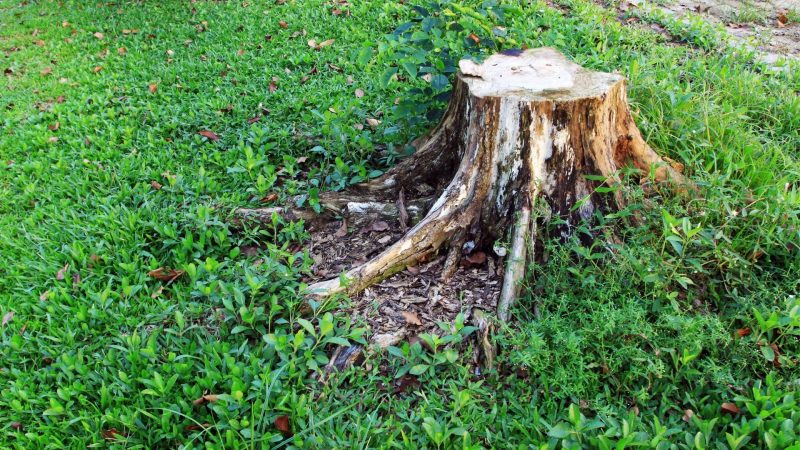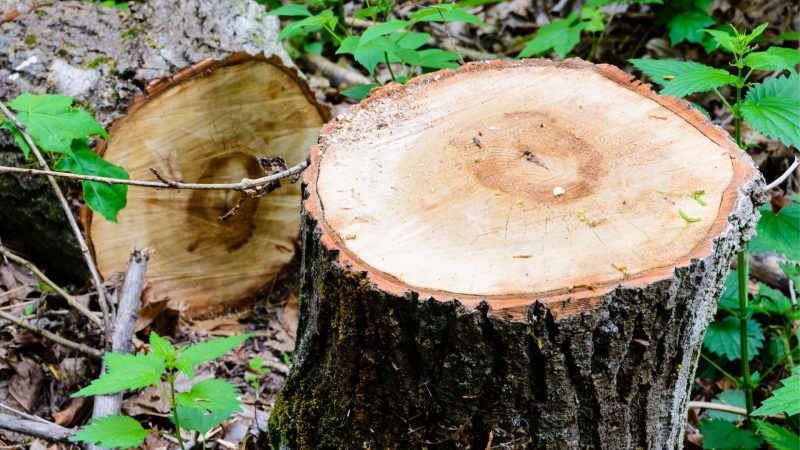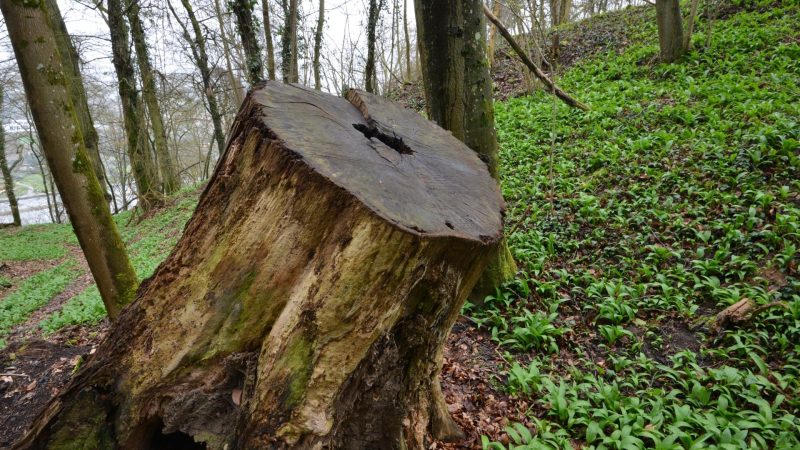A tree stump isn’t only an eyesore to property but can also cause safety concerns and draw invasive insects. Thus, killing a tree stump is a must.
But, how do you kill a tree stump? There are many ways to kill tree stumps, but one of the most effective methods is the use of Epsom salt. To use this method, drill at least one-inch holes to the tree stump and sprinkle Epsom salt into the holes. After that, pour in some water. Apply the Epsom salt at least once a week for up to 8 to 10 weeks.
This method work by accelerating the decomposition process down to 6 to 12 months, which usually takes 3 to 7 years to rot naturally. The Epsom salt contains sulfur and magnesium that can be deadly to plants if applied in large quantities.
What to Do With Tree Stumps?

Since tree trumps can pose possible accidents and invite destructive pests, such as ants and termites, it’s best to remove them or put them to good use. If you love to get creative, you can transform tree stumps into:
- Planter
- Fairy house
- Glow in the dark tree stump stools
- Mosaic garden stump
- Birdbath
- Gnome house
- Coffee table
- Candleholder
- Plant stand
What Happens if You Leave a Tree Stump?
If you leave a tree stump, it’ll eventually decay and attract many pests, fungi, and organisms that cause various diseases. This can create serious problems, such as:
Pest and Insect Infestation
The tree stumps left in the ground will begin to rot with the aid of organisms. Some of these organisms are:
- Termites
- Snakes
- Beetles
- Fungi
- Various ant species
- Wood wasps
- Rodents
These organisms will eventually spread out to other trees, shrubs, and even to your home, causing costly damages that will be time-consuming to eliminate. In addition, the stump can also regrow into a full-grown tree if there are enough nutrients in the roots to help regrow the sprouts sticking on the ground.
How Long Does It Take for a Tree Stump to Rot?

The natural decomposition of a tree stump takes about 3 to 7 years. However, if you drill holes to the stump and apply Epsom salt, it’ll only take 6 to 12 months to rot.
Can a Stump Grow Back Into a Tree?
A tree stump can grow back into a full-grown tree, given that the roots have enough nutrients to regrow the tree through the sprouts that are sticking on the ground.
How to Get Rid of Tree Stumps?
You can get rid of a tree stump by quickening its decomposition process or by hand. To hasten its rotting process, you can use:
Epsom Salt
Epsom salt contains magnesium and sulfur that are good for plants but deadly if used in large volumes. This is a good solution for homeowners wanting to deal with a tree stump in a slower, natural approach.
Rock Salt
This is similar to Epsom salt. Just drill holes into the tree stump, then fill the holes with rock salt. Once done, put some soil and mulch, cover the stump, and pour water over the mulch.
Pouring the water over the mulch will dissolve the salt, helping the roots to absorb the solution. This will also help in hastening the decomposition process.
Cover the Stump With Plastic or Tarp
This is one of the effective methods of getting rid of a stump. This method kills the stump by not allowing it to receive the sunlight it needs to survive.
Without sunlight, the stump will decompose much faster, needing just at least two to three months to start its rotting process. All you need to do is:
Step 1: Cut the stump close to its root with a chainsaw, handsaw, or hatchet.
Step 2: Cover the stump with a trash bag (preferably the black one).
Step 3: After that, put heavy rocks or bricks on the cover.
This method will not require much effort, but its effect could be slower compared to the physical removal techniques.
How to Rot a Tree Stump Fast?
To rot a tree stump fast, use Epsom salt. Just drill holes of at least one inch into the stump and fill Epson salt into the holes. Once done, make sure to pour some water into the stump’s surface to allow the salt to melt and absorb well into the roots.
How to Burn a Tree Stump?
To burn a tree stump, you need to use some kindling or kerosene. Although this method can kill the tree, it won’t completely eliminate the tree roots and stumps.
This procedure isn’t ideal to use if you’re from a place prone to wildfires. It’s best to talk with your local fire department to confirm if burning a tree stump is okay in your area.
Once you get the approval of the local fire unit to burn your tree stump, you can start to:
Step 1: Drill holes into the trunk.
Step 2: Pour kerosene in every hole.
Step 3: Light the scrap wood on the stump’s surface and monitor the burning wood carefully.
Although this method can be slower compared to digging the tree stump out of your yard, the burn goes deeper within the stump, killing the roots effectively.
How to Remove Small Tree Stumps?
To remove small tree stumps in your yard, consider doing the following steps:
Step 1: Expose as many roots as possible by digging around the stump.
Step 2: Then, use a handsaw, chainsaw, or hatchet in cutting larger roots. If you find smaller roots, use clippers or loppers to remove them.
Step 3: After removing all the roots, you can then lift and eliminate the stump from the ground.
How to Kill a Tree Stump by Hand?
There are various ways to remove a tree by hand, and these involve:
Tree Grinding
Tree grinding can be an extensive process, depending on the size of the tree stump. Some can last only up to two hours, while other tree grinding services can last six to seven hours.
Grinding the tree stump is undoubtedly the fastest way to kill a tree stump. This method involves hiring a tree removal expert or renting a stump grinder machine to break the wood apart in the trunk and tree roots.
Hiring a tree removal service can cost around $100 to $400 while renting a tree grinder costs $80 to $150 for four hours. If you want to do the tree grinding yourself, make sure to start by trimming the stump with a chainsaw.
Then, dig around the stump and remove the rocks. After that, use the cutter blade of the machine to break away the wood and cut the roots linked to the stump. Once done, put soil over the stump and add some mulch.
Stump Digging
Digging a tree stump out of the ground is another way to eliminate it from your property. However, this can be time-consuming and destructive to your lawn.
To use this method:
Step 1: Expose the roots of the stump by digging around it.
Step 2: Use a chainsaw or a handsaw to cut the larger roots. For smaller roots, use clippers or loppers.
Step 3: After removing all the roots, lift and remove the stump, then fill the hole with soil and cover it with mulch.
How Does Epsom Salt Remove a Tree Stump?

To remove a tree stump using Epsom salt, drill at least one-inch holes into the stump. After that, sprinkle or fill the stump holes with salt. Then, pour in some water and reapply as needed.
The salt will melt faster because of the water that will cause fast absorption to the roots. This will quicken the decomposition process of up to 3 to 12 months instead of 3 to 7 years.
What Are the Effective Tree Stump and Root Killer?
Since there are many stump and root killer products in the market currently, we have listed some of the in-demand tree stump killer items to help you with your choices:
Bonide and Stump Killer
This item prevents the stump from re-sprouting, making it an effective solution for stump removal.
Pros:
- Effective in preventing stump from re-sprouting.
- Economical
- Easy application
- Doesn’t harm plants
Cons:
- Expensive than other brands
- Require frequent brushing
Note: Make sure to read the product’s label for proper usage to get the best result.
Spectracide Stump Remover
The spectracide stump remover effectively helps in accelerating the decomposition process. This means you can have the stump rot as fast as 3 to 12 months.
Just drill several 1 inch to 12 inches holes into the stump and do the same into its sides with 3 to 4 inches from the top in a slanting manner. Once done, pour the Spectracide Stump Remover Granules into every hole.
After that, fill the holes with hot water to dissolve the granules. Don’t also forget to read the complete instructions on the label for effective use.
Pros:
- Quicken decomposition process
- Kill newly cut stumps
- Easy to apply
- No odor
- Affordable
Cons:
- Drilling holes is required.
VPG Fertilome Brush Stump Killer
This product helps control the growth of unwanted plants and stumps. To use, apply undiluted VPG Fertilome Brush Stump Killer by covering the newly cut surface using a paintbrush.
Pros:
- Controls the growth of unwanted vines and plants.
- Easy to apply
Cons:
- Expensive
How Do You Seal a Tree Stump Left in the Ground?
Sealing a tree stump can prevent it from rotting. This means your stump won’t attract any pests that can cause damage to your property and bring in diseases.
To seal a tree stump:
Step 1: Use a small to medium brush size.
Step 2: Apply 2 to 3 polyurethane wood sealants over the stump surface. Make sure to cover the stump from top to all sides.
Step 3: Leave the sealant for at least 48 hours to dry.
Will Stump Grindings Attract Termites?

Stump grindings can’t attract termites because they don’t possess unique scents. However, if termites stumble upon the stump grindings, they’ll make a colony and spread on your property.
What Can You Do With Wood Chips After Stump Grinding?
Wood chips can make an excellent mulch. So, after stump grinding, use the wood chips as mulch and spread it over the soil.
After that, rake the mulch to the flower beds, allowing the grindings to rot and add nutrients to your soil.
Will Grass Grow in Stump Chips?
In most cases, the grass won’t grow in stump chips as the stump debris robs the soil of nitrogen. This prevents the grass from growing in the area.
Summary
Removing a stump in your property is a must to address safety concerns. In addition, it prevents invasive and destructive pests, such as carpenter ants and termites, from settling in your place.